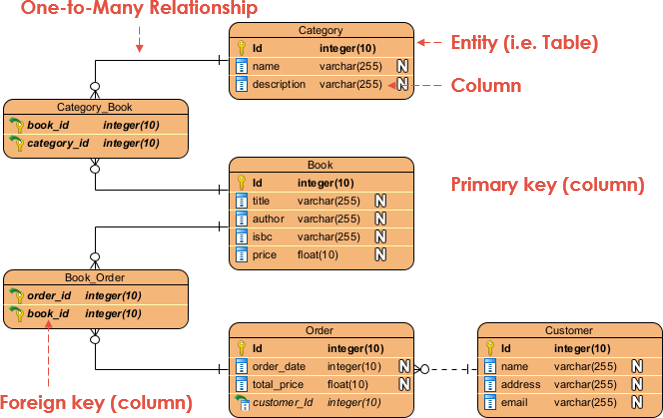Building an Online Bookstore: Data Modeling with ERD and DBML
Data modeling is the process of creating a visual representation of the data and its relationships in a database. One of the most commonly used tools for data modeling is the Entity Relationship Diagram (ERD), which uses graphical symbols to represent entities, attributes, and relationships. In this article, we will explore the process of data modeling using an ERD and provide examples of how it can be used in real-world scenarios.
What is an Entity Relationship Diagram (ERD)?
An ERD is a graphical representation of entities, their attributes, and the relationships between them. Entities are objects or concepts that are represented in the database, such as customers, orders, or products. Attributes are characteristics or properties of entities, such as name, address, or price. Relationships are associations between entities, such as a customer placing an order.
ERDs are typically composed of the following components:
- Entities: represented as rectangles with the entity name written inside.
- Attributes: represented as ovals connected to the entity they belong to by a line.
- Relationships: represented as diamonds connecting entities.
The three types of relationships that can exist between entities are:
- One-to-One (1:1): where one instance of an entity is associated with one instance of another entity.
- One-to-Many (1:N): where one instance of an entity is associated with multiple instances of another entity.
- Many-to-Many (N:M): where multiple instances of an entity are associated with multiple instances of another entity.
Example of Data Modeling using ERD
Let us consider an example of an online bookstore that sells books to customers. The bookstore has multiple book categories and a large number of customers who can place orders. In order to model this system using an ERD, we can start by identifying the entities, attributes, and relationships that are involved.
Entities:
- Book: Represents a book in the bookstore. Contains attributes such as title, author, ISBN, and price.
- Category: Represents a category or genre of books in the bookstore. Contains attributes such as name and description.
- Customer: Represents a customer who has registered with the bookstore. Contains attributes such as name, address, and email.
- Order: Represents an order placed by a customer. Contains attributes such as order date and total price. Also has a foreign key reference to the Customer entity, indicating which customer placed the order.
- Book_Category: Represents the many-to-many relationship between books and categories. Contains foreign key references to both the Book and Category entities.
- Order_Book: Represents the many-to-many relationship between orders and books. Contains foreign key references to both the Order and Book entities.
Relationships:
- One book can belong to multiple categories (Many-to-Many).
- One category can have multiple books (One-to-Many).
- One customer can place multiple orders (One-to-Many).
- One order can contain multiple books (Many-to-Many).
With these entities, attributes, and relationships in mind, we can create an ERD for the online bookstore system. The ERD would look something like this:

In this ERD diagram, we can see that the Book entity has a many-to-many relationship with the Category entity, which means that a book can belong to multiple categories, and a category can have multiple books. The Customer entity has a one-to-many relationship with the Order entity, which means that a customer can place multiple orders, but each order belongs to only one customer. Finally, the Order entity has a many-to-many relationship with the Book entity, which means that an order can contain multiple books, and a book can appear in multiple orders.
Generate the Database Schema SQL Code with Visual Paradigm
Table book {
id int [pk, increment]
title varchar
author varchar
isbn varchar
price float
}Table category {
id int [pk, increment]
name varchar
description varchar
}Table customer {
id int [pk, increment]
name varchar
address varchar
email varchar
}Table order {
id int [pk, increment]
order_date datetime
total_price float
customer_id int [ref: > customer.id]
}Table book_category {
book_id int [ref: > book.id]
category_id int [ref: > category.id]
}Table order_book {
order_id int [ref: > order.id]
book_id int [ref: > book.id]
}
Conclusion
Data modeling using ERDs is an important process that helps us to visualize and understand the relationships between entities in a database. By identifying entities, attributes, and relationships, we can create an ERD that represents the data and its structure in a clear and concise manner. This enables us to design and maintain efficient and effective databases that can support the needs of the organization.

